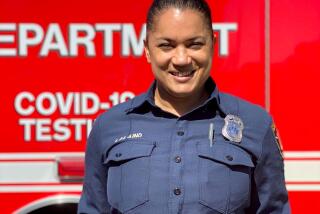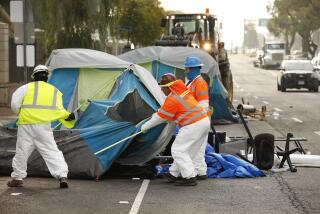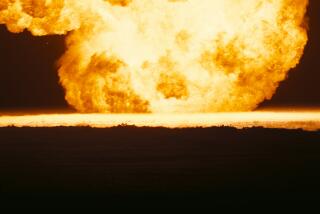FBI Expert Admits Lapses in Bombing Evidence Analysis
DENVER â Troubles at the FBI crime laboratory were introduced in testimony at the Oklahoma City bombing trial here Tuesday as a senior lab official acknowledged a series of shortcomings in the bureauâs analysis of evidence from the 1995 tragedy.
Testifying under cross-examination by a lawyer for defendant Timothy J. McVeigh, the FBIâs acting chief of the labâs chemistry and toxicology unit conceded that he was so rushed during his visit to Oklahoma City after the bombing that he never entered the damaged building to collect bomb residue samples--tests the defense suggests might have found evidence of another kind of bomb.
Steven Burmeister, the lab official, also testified that it was unclear who was supervising the labâs review of the blast at the Alfred Murrah Federal Building.
âThere were many hats being worn,â he said. âIâm not sure who was in charge of the laboratory.â
The defense suggests that poor supervision created a chaotic atmosphere that allowed for mistakes and incomplete work.
Under questioning, Burmeister said that examinations of McVeighâs alleged getaway car and a series of storage lockers where he reportedly kept bomb components had not found any traces of the ammonium nitrate allegedly used in the bomb.
The cross-examination came as prosecutors neared the end of presentation of evidence against McVeigh and it offered the defense a chance to play one of its strongest cards so far--conclusions by the Justice Department inspector general that the lab suffered from serious problems, ranging from sloppy procedures to exaggerated conclusions.
The inspector generalâs review had led the FBI to suspend the two other analysts who had joined with Burmeister in testing material from the bombing case. Those suspensions cast such doubts on the credibility of the two analysts that prosecutors chose not to call them as witnesses.
Burmeister testified that Frederic Whitehurst, who later became the major whistle-blower on conditions at the FBI laboratory, had been his training supervisor. Burmeister said that he once had held Whitehurst in high esteem. âAt the time that I worked with him, I respected his abilities,â Burmeister said.
Burmeister said that he was late getting to the bomb site because of a severe thunderstorm that hit Oklahoma City that day. He and other lab personnel had to spend the night in Little Rock, Ark., before arriving in Oklahoma City the following day, April 20.
He said he realized immediately that the heavy rains could wash away much of the evidence of explosives in the bombing debris, primarily because nitrates enter the environment through rainwater.
One of the major government finds in the debris was a small piece from inside the truck, which Burmeister testified Monday contained traces of explosives material. But under questioning by defense attorney Chris Tritico on Tuesday, he acknowledged that he did not examine the area around the spot where the piece was found to see if it could have been contaminated by other elements.
âI didnât check the soil or the surface around that object,â Burmeister said.
He said that he found âhigh levelsâ of ammonium and nitrate ions in some of the broken glass from the Murrah building. But again, he acknowledged that he did not check to see where the glass was manufactured or what chemical solvents were used to clean the glass to determine whether it, too, could have been contaminated before the blast.
âWithout control samples, I was not able to draw any conclusions,â he said.
Burmeister said that he had collected about 10 chemical swabs of evidence when he was paged and told to go to Kansas. âIt was part of my strategy toâ search the interior of the damaged Murrah building, he said. âBut I didnât have time to do it.â
Those tests conceivably could have found a type of explosives ingredient that was not consistent with the small amount of explosives material he detected on the truck panel.
In Kansas, he performed tests at co-defendant Terry L. Nicholsâ home in Herington and storage lockers in Herington and nearby Council Grove.
Burmeister said that he swabbed the door handle and walls at the Herington locker but found no explosives residue. He said that he did find traces of nitroglycerin at the Council Grove locker. But it was discounted because ammunition had been stored there.
Burmeister said that McVeighâs clothing was shipped to Washington in a paper bag. âI would say that there are better methods of transportation,â he said. Once at the lab, he found traces of explosives on the clothing.
But, he said, there was never any internal testing done at the lab to see if evidence of any kind had been tainted by contaminants. âThere was no testing done,â he said.
And he said there were no protocols requiring special clothing to be worn by lab workers, and that sometimes agents who had been at the FBI gun range walked through the lab, which could also lead to contamination.
Defense attorneys also sought to ask Burmeister about problems at the lab not specifically related to the Oklahoma City bombing, but U.S. District Judge Richard P. Matsch would not allow it. For instance, Tritico was prevented from asking Burmeister about the other lab personnel removed from their jobs and whether he was interviewed by the inspector general.
But the defense almost certainly will get a second chance to question Burmeister because the defense case, which could begin later this week, is likely to center on the lab. Defense attorneys may even call Whitehurst to the stand to discuss the labâs shortcomings.
The government contends that McVeigh and Nichols purchased 4,000 pounds of ammonium nitrate and fuel oil, mixed the components and loaded the material into the back of a Ryder truck. McVeigh then drove the truck to Oklahoma City and on April 19, 1995, detonated the bomb in front of the Murrah building, the government alleges. The blast killed 168 people and injured 500.
McVeigh, if convicted, could face the death penalty. He has pleaded not guilty. Nichols, who is to be tried later, also has maintained his innocence.
More to Read
Sign up for Essential California
The most important California stories and recommendations in your inbox every morning.
You may occasionally receive promotional content from the Los Angeles Times.











